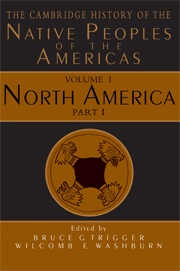Book contents
- Frontmatter
- 1 Native views of history
- 2 Native peoples in Euro-American historiography
- 3 The first Americans and the differentiation of hunter-gatherer cultures
- 4 Indigenous farmers
- 5 Agricultural chiefdoms of the Eastern Woodlands
- 6 Entertaining strangers: North America in the sixteenth century
- 7 Native people and European settlers in eastern North America, 1600–1783
- 8 The expansion of European colonization to the Mississippi Valley, 1780–1880
- Index
- References
7 - Native people and European settlers in eastern North America, 1600–1783
Published online by Cambridge University Press: 28 March 2008
- Frontmatter
- 1 Native views of history
- 2 Native peoples in Euro-American historiography
- 3 The first Americans and the differentiation of hunter-gatherer cultures
- 4 Indigenous farmers
- 5 Agricultural chiefdoms of the Eastern Woodlands
- 6 Entertaining strangers: North America in the sixteenth century
- 7 Native people and European settlers in eastern North America, 1600–1783
- 8 The expansion of European colonization to the Mississippi Valley, 1780–1880
- Index
- References
Summary
As the seventeenth century opened, the relationship between Native peoples and Europeans in North America east of the Mississippi had an established history but uncertain future. Over the preceding century, the presence of Europeans, their goods, and their microbes had affected many Indians, particularly on the eastern seaboard and in the southeastern interior. Depopulation and migration had caused the disappearance of numerous communities, and European goods had begun to constitute a small but significant portion of many groups’ material cultures. These changes, in turn, had brought alterations in subsistence, social and political organization, exchange, and patterns of alliance and rivalry.
Yet for all the transformations they had experienced, eastern North Americans continued to understand themselves, the world they lived in, and even the newcomers, in terms that were essentially rooted in their precontact lifeways and values. Most Indian communities still occupied the familiar, well-defined territories from which they had long drawn their material needs and within which they had constructed their cultural identities and their relations with other groups. And in spite of all their efforts to establish a more substantial presence, Europeans remained outsiders everywhere (except around St. Augustine in Florida) as the sixteenth century drew to a close.
All this would change after 1600. The next two centuries witnessed the explosive and historically unprecedented spread of European societies, economies, and cultures in one form or another throughout the eastern portion of the continent. Colonization would pose serious challenges to Indians’ ability to maintain continuity in and control over their ways of life, their homelands, and their cultural identities.
- Type
- Chapter
- Information
- The Cambridge History of the Native Peoples of the Americas , pp. 399 - 460Publisher: Cambridge University PressPrint publication year: 1996
References
- 2
- Cited by



